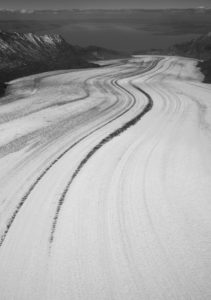Scientists use satellite gravity measurements to monitor ice changes
1 June 2020

Straddling the Chile-Argentina border, Viedma Glacier is, like many other such entities around the world, under increasing risk of rapid melting due to climate change.
Credit: Jeremie Mouginot / UCI
AGU contact:
Liza Lester, +1 (202) 777-7494, [email protected]
University of California, Irvine contact:
Brian Bell, +1 (949) 565-5533, [email protected]
Contact information for the researchers:
Isabella Velicogna, University of California, Irvine, [email protected]
WASHINGTON—The mass of ice held in Earth’s glaciers and ice caps outside of Greenland and Antarctica decreased by more than 280 billion metric tons per year on average between 2002 and 2019, resulting in a 13-millimeter rise in global sea levels, a new study in AGU’s journal Geophysical Research Letters found.
This ice loss depletes freshwater resources that serve millions of people around the world, according to the new study.
By “weighing the Earth,” with satellite-borne instruments, the new study demonstrated a powerful tool to monitor and measure the planet’s water reserves, including all land ice and groundwater, Isabella Velicogna, a researcher at the University of California Irvine and NASA’s Jet Propulsion Laboratory, and an author of the new study, said.
“In the Andes Mountains in South America and in high-mountain Asia, glacier melt is a major source of drinking water and irrigation for several hundred million people,” Velicogna said.
“Our research revealed that these freshwater resources in glaciers and ice caps are globally dwindling down, faster every year,” she said. “And this will increase the risk of water scarcity and water conflicts in many parts of the world.”
The new study found Alaska lost the most ice, followed by Canada’s ice caps, the southern Andes Mountains, high-mountain Asia (the Himalayas), the Russian Arctic, Iceland and Svalbard. These areas made up 94 percent of the total mass loss. The other six percent was distributed in smaller regions of Central Europe, the Caucasus, Central America, North Asia, Scandinavia and the low latitudes.
The researchers measured the ice mass loss using data from the Gravity Recovery and Climate Experiment satellite mission and its successor, GRACE Follow-On, a joint project of NASA and the German Aerospace Center. They used independent glacier surface mass balance data (a comparison of melting/runoff to snow accumulation) from the Modern-Era Retrospective Analysis for Research and Applications, Version 2, from NASA’s Global Modeling and Assimilation Office, to reconcile the several-month gap between the satellite missions.
Lead author Enrico Ciraci, a UCI graduate student researcher in Earth system science, said that the MERRA-2 data lined up amazingly well with the GRACE/GRACE-FO data.
The project accounted for not only the total loss of ice mass but also the acceleration of the decline over the past few decades to the present day. For example, in 2002 the rate of loss was 240 billion metric tons, while in 2019 it was 324 billion metric tons.
Velicogna said the paper holds an important message for people around the world.
“The GRACE and GRACE-FO missions provide a unique way to survey the freshwater resources locked in remote areas, across political boundaries, with precision data,” she said. “The results are bad, bad news for global freshwater from glaciers.”
Velicogna noted that it’s important for scientists such as herself to continually define consistent methodologies to monitor glacier melt, not just to keep track of potential sea level rise but for the management of freshwater resources by local governments.
This project, which also involved experts from the National Center for Atmospheric Research in Boulder, Colorado, was funded by NASA.
###
AGU (www.agu.org) supports 130,000 enthusiasts to experts worldwide in Earth and space sciences. Through broad and inclusive partnerships, we advance discovery and solution science that accelerate knowledge and create solutions that are ethical, unbiased and respectful of communities and their values. Our programs include serving as a scholarly publisher, convening virtual and in-person events and providing career support. We live our values in everything we do, such as our net zero energy renovated building in Washington, D.C. and our Ethics and Equity Center, which fosters a diverse and inclusive geoscience community to ensure responsible conduct.
Notes for Journalists
This paper is open access. Journalists and public information officers (PIOs) can download a PDF copy of the article by clicking on this link: https://agupubs.onlinelibrary.wiley.com/doi/epdf/10.1029/2019GL086926
Journalists and PIOs may also request a copy of the final paper by emailing Liza Lester at [email protected]. Please provide your name, the name of your publication, and your phone number.
Neither the paper nor this press release is under embargo.
Paper Title
“Continuity of the Mass Loss of the World’s Glaciers and Ice Caps From the GRACE and GRACE Follow‐On Missions”
Authors
E. Ciracì, Department of Earth System Science, University of California Irvine, Irvine, CA, USA
I. Velicogna, Department of Earth System Science, University of California Irvine, Irvine, CA, USA; Jet Propulsion Laboratory, California Institute of Technology, Pasadena, CA, USA
S. Swenson, National Center for Atmospheric Research, Boulder, CO, USA